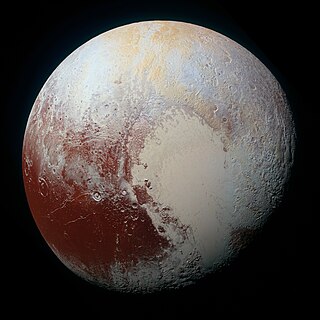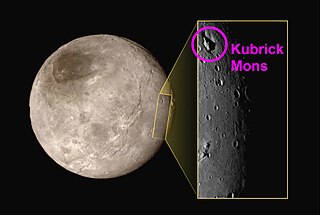
Pluto is a dwarf planet in the Kuiper belt, a ring of bodies beyond the orbit of Neptune. It is the ninth-largest and tenth-most-massive known object to directly orbit the Sun. It is the largest known trans-Neptunian object by volume, by a small margin, but is less massive than Eris. Like other Kuiper belt objects, Pluto is made primarily of ice and rock and is much smaller than the inner planets. Pluto has roughly one-sixth the mass of Earth's moon, and one-third its volume.

Charon, known as (134340) Pluto I, is the largest of the five known natural satellites of the dwarf planet Pluto. It has a mean radius of 606 km (377 mi). Charon is the sixth-largest known trans-Neptunian object after Pluto, Eris, Haumea, Makemake, and Gonggong. It was discovered in 1978 at the United States Naval Observatory in Washington, D.C., using photographic plates taken at the United States Naval Observatory Flagstaff Station (NOFS).

The geology of Pluto consists of the characteristics of the surface, crust, and interior of Pluto. Because of Pluto's distance from Earth, in-depth study from Earth is difficult. Many details about Pluto remained unknown until 14 July 2015, when New Horizons flew through the Pluto system and began transmitting data back to Earth. When it did, Pluto was found to have remarkable geologic diversity, with New Horizons team member Jeff Moore saying that it "is every bit as complex as that of Mars". The final New Horizons Pluto data transmission was received on 25 October 2016. In June 2020, astronomers reported evidence that Pluto may have had a subsurface ocean, and consequently may have been habitable, when it was first formed.

Nix is a natural satellite of Pluto, with a diameter of 49.8 km (30.9 mi) across its longest dimension. It was discovered along with Pluto's outermost moon Hydra on 15 May 2005 by astronomers using the Hubble Space Telescope, and was named after Nyx, the Greek goddess of the night. Nix is the third moon of Pluto by distance, orbiting between the moons Styx and Kerberos.

Hydra is a natural satellite of Pluto, with a diameter of approximately 51 km (32 mi) across its longest dimension. It is the second-largest moon of Pluto, being slightly larger than Nix. Hydra was discovered along with Nix by astronomers using the Hubble Space Telescope on 15 May 2005, and was named after the Hydra, the nine-headed underworld serpent in Greek mythology. By distance, Hydra is the fifth and outermost moon of Pluto, orbiting beyond Pluto's fourth moon Kerberos.

The dwarf planet Pluto has five natural satellites. In order of distance from Pluto, they are Charon, Styx, Nix, Kerberos, and Hydra. Charon, the largest, is mutually tidally locked with Pluto, and is massive enough that Pluto and Charon are sometimes considered a binary dwarf planet.

Kerberos is a small natural satellite of Pluto, about 19 km (12 mi) in its longest dimension. Kerberos is also the second-smallest moon of Pluto, after Styx. It was the fourth moon of Pluto to be discovered and its existence was announced on 20 July 2011. It was imaged, along with Pluto and its four other moons, by the New Horizons spacecraft in July 2015. The first image of Kerberos from the flyby was released to the public on 22 October 2015.

Belton Regio is a prominent surface feature of the dwarf planet Pluto. It is an elongated dark region along Pluto's equator, 2,990 km (1,860 mi) long and one of the darkest features on its surface.

Mordor Macula is the informal name for a large dark area about 475 km in diameter near the north pole of Charon, Pluto's largest moon. It is named after the black land called Mordor in J.R.R. Tolkien's The Lord of the Rings.

The geology of Charon encompasses the characteristics of the surface, crust, and interior of Pluto's moon Charon. Like the geology of Pluto, almost nothing was known of Charon's geology until the New Horizons of the Pluto system on 14 July 2015. Charon's diameter is 1,208 km (751 mi)—just over half that of Pluto. Charon is sufficiently massive to have collapsed into a spheroid under its own gravity.

The geography of Pluto refers to the study and mapping of physical features across the dwarf planet Pluto. On 14 July 2015, the New Horizons spacecraft became the first spacecraft to fly by Pluto. During its brief flyby, New Horizons made detailed geographical measurements and observations of Pluto and its moons.

Kubrick Mons is the name given to the largest of a series of mountain peaks on Pluto's moon Charon that rise out of depressions in the Vulcan Planitia region. The feature was first recorded by the Long Range Reconnaissance Imager (LORRI) aboard the New Horizons spacecraft during a flyby on 15 July 2015.

Vulcan Planitia, or Vulcan Planum, is the unofficial name given to a large plain on the southern hemisphere of Pluto's moon Charon. It discovered by New Horizons during its flyby of Pluto in July 2015. It is named after the fictional planet Vulcan in the science-fiction series Star Trek. The name is not approved by International Astronomical Union (IAU) as of 2024.

The Coleta de Dados Colles are a cluster of hills ("colles") on the smooth plains of Sputnik Planitia on Pluto. The hills are over 100 km from the major mountain ranges to the west, and appear to be blocks of water ice floating in the denser nitrogen ice of Sputnik Planitia. The hills were informally named on July 28, 2015, by the research team of the New Horizons mission after the first Brazilian satellite, the Satélite de Coleta de Dados. The ridge's name has yet to be recognized officially by the IAU.

Vader is the unofficial name given to a dark crater on Pluto's largest moon Charon. The floor of Vader is darker than the surrounding terrain, covered in the same reddish-brown dark material that covers Mordor Macula on Charon's north pole. Though Charon's surface trends darker with increasing latitude, some craters, such as Vader, interrupt this trend. The crater was discovered by NASA's New Horizons space probe on its way by Pluto. It is named after the character Darth Vader from the Star Wars media franchise; the name has yet to be officially approved by the International Astronomical Union (IAU).

Mandjet Chasma is a chasma on Pluto's moon Charon. Mandjet Chasma is 385 km (239 mi) long, and about 5–7 km (3.1–4.3 mi) deep with an average width of 30 km (19 mi). The chasma is part of a global tectonic belt: a series of canyons, scarps, and troughs that traverse the face of Charon along the northern edge of Vulcan Planitia. The feature was discovered using stereoscopic processing of New Horizons images.

Serenity Chasma is the unofficial name given to a large pull-apart fault on Pluto's moon, Charon. It is part of a series of faults that run along the perimeter of Vulcan Planum. It was discovered by the New Horizons mission, and informally named after the fictitious spaceship, Serenity.

The climate of Pluto concerns the atmospheric dynamics, weather, and long-term trends on the dwarf planet Pluto. Five climate zones are assigned on the dwarf planet: tropics, arctic, tropical arctic, diurnal, and polar. These climate zones are delineated based on astronomically defined boundaries or sub-solar latitudes, which are not associated with the atmospheric circulations on the dwarf planet. Charon, the largest moon of Pluto, is tidally locked with it, and thus has the same climate zone structure as Pluto itself.

Caleuche Chasma is a Y-shaped chasma on Pluto's moon, Charon. Caleuche Chasma is 400 km (250 mi) long. The feature was discovered using stereoscopic processing of New Horizons images. At approximately 13 km (8.1 mi) deep, it is the deepest known feature on the natural satellite, and one of the deepest known canyons in the Solar System.



















